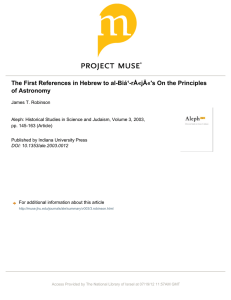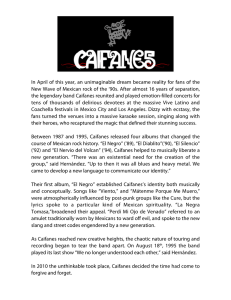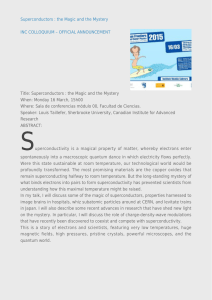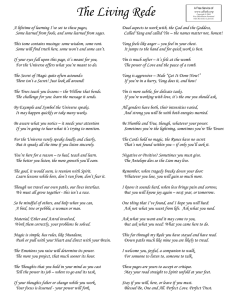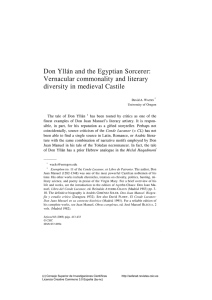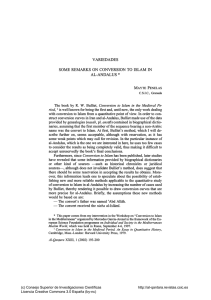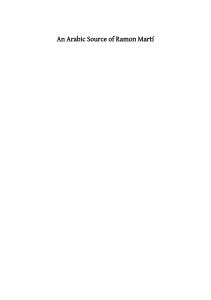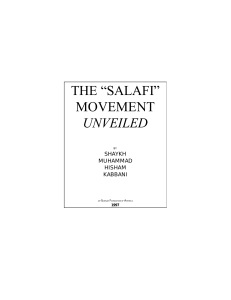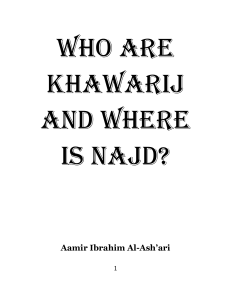IBN WAHSHIYYA AND MAGIC Magic has always had a role to play
Anuncio
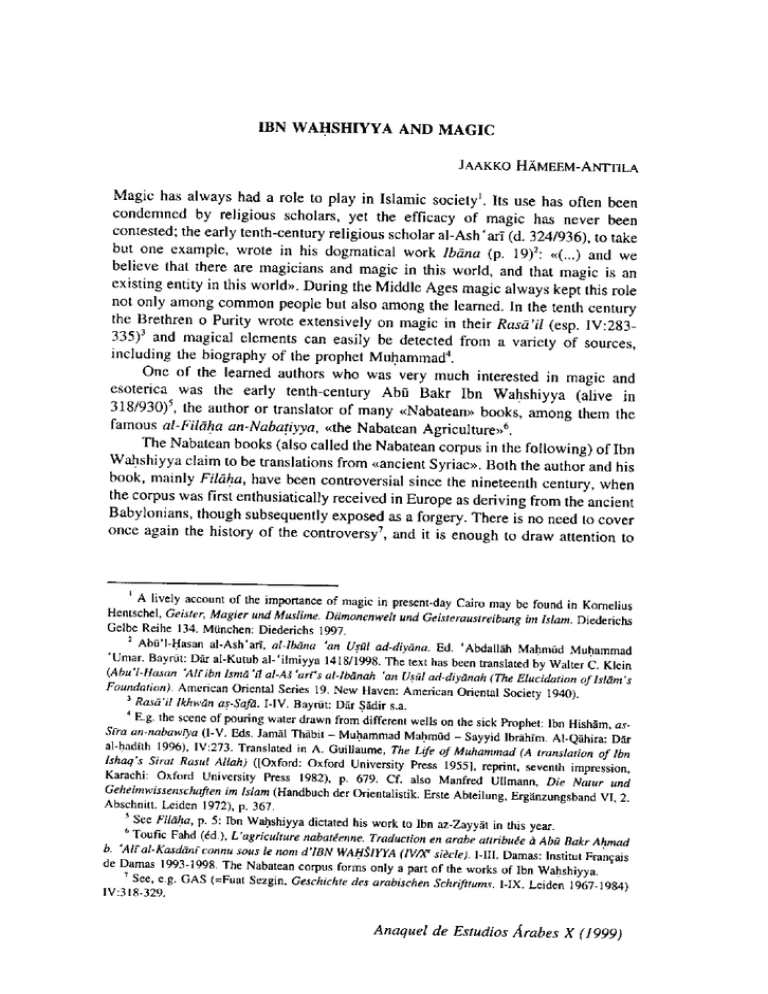
IBN WAHSHIYYA AND MAGIC JAAKKO HÁMEEM-ANTrILA Magic has always had a role to play in Islamie society’. Its use has often been condemned by religious scholars, yet the efficacy of magic has never been contested; the early tenth-century religious scholar al-Ash ‘arT (d. 324/936), to take but one example, wrote in his dogmatical work Ibána (p. 19)’: «(...) and we belíeve that there are magicians and magie in this world, and that magic is an existing entity in this world». During the Middle Ages magic always kept this role not only among common people but also among the learned. In the tenth century the Brethren o Purity wrote extensively on magie in their Rasa’il (esp. IV:283335)3 and magical elements can easily be detected from a variety of sources, including the biography of the prophet Muhammad4. One of the learned authors who was very much interested in magic and esoterica was the early tenth-century Abo Bakr Ibn Wahshiyya (alive in 318/930)~, the author or transíator of many «Nabatean» books, among them the famous al-Filaha an-Nabatiyya, «the Nabatean Agriculture>0. The Nabatean books (also called the Nabatean corpus in the following) of Ibn Wahshiyya claim to be translations from «ancient Syriac». Both the author and his book, mainly Filáha, have been controversial since the nineteenth century, when the corpus was first enthusiatically received in Europe as deriving from the ancient Babylonians, though subsequently exposed as a forgery. There is no need to cover once again the history of the controversy’, and it is enough to draw attention to A lively account of the insportance of magic in present-day Cairo nsay be found in Komelius I-lentschel, Geister, Magier ¡md Muslime. Ddmonenwelt uniX Geisreraustreibung br> Islam. Diedeíichs Gelbe Reihe 134. Munchen: Diederichs 1997. ‘ Abfil-Hasan al-Ash’ar¡, ol-Ibana ‘an 1./sal ad-diyana. Ed. ‘Abdalláh Mahmúd Muhammad ‘t/mar. Bayrút: Dár al-Kutub al-ilmiyya 1418/1998, The text has been transíaced by Walter C. Klein (Abu ‘¿-Hasan ‘AIFibn Isnsñ ‘jI al-A} ‘arf’s at-Ibdnali ‘an (Js,7l ad-diyanaIt (TIte Elucidarían ofIslam ‘s Foandarion). American Oriental Series 19. New Haven: American Oriental Society 1940). Rosa il IkItwan as-Safa. 1-1V. Hayrdt: Dár Sádir sa. Eg. the seene of pouring waíer drawn from differenr wells on the sick Propheí: lbn Hishám, asSfra an-nabawrya (1-y. Ms. Jamál Thábir — Muhansmad Mahmñd — Sayyid lbráhrm. AI-Qáhira: Dár al-hadfíh 1996), IV:273. Transíated in A. Guillaume, TIte L<fe of Muhommad (A transíation of Hm Isliaqs Sirar Rosul Alioli) (lOxford: Oxford liniversity Press 19551, reprint, sevenih impression, Karachi: Oxford liniversiíy Press 1982), p. 679. Cf. also Manfred tillmann, ¡Ile Narur und Gelieiniwissenscliafien im Islam (Handbueh der Orientalistilo. Erste Abteilung, Ergánzungsband VI, 2. Abschniít. Leiden 1972), p. 367. ‘ See Fila/ja, p. 5: lbn Wahshiyya dictated bis work to Ibn az-Zayyát in this year. 6 Toufic Fahd (¿d.), tagriculture nabaréenne. Traducrion en arobe auribuée bAbo Bakr Ahmnad b. ‘AlFal’Kasdanrconnu sous le nom d’IBN WAHÉIYyA ji ‘¡ix st#.cle). 1-111. Damas: Instituí Fran~ais de Damas 1993-1998. The Nabatean corpus forms only a part of be works of lbn Wahshiyya. See, eg. GAS (=Fuat Sezgin. Gesch ¿elije des arabisc/len Schr<fuums. 1-15<. Leiden 1967-1984) IV:3 ¡8-329. Anaquel de Estudios Árabes X (1999) 40 Jaakko Harneen-A nttila the present situation. The majority of scholars bave more or less ignored both Ibn Wahshiyya and his works8, whereas a few, especially Toufic Fahd, have courageously but not always coherently defended the authenticity of Filaha, not as a remnant of ancient Babylonian literature but as an authenticity Arabic transíation of a fourth/fifth century AD pseudepigraphic Aramic text9. The other works of Ibn Wahshiyya have received extremely scant attention, despite their obvious importance as a source for the almost unknown rural and parochial life in Iraq. In the final analysis the question of the texts exact provenience must still be left open, though the lack of any signs of transíation in the texts as well as the absence of similar genuine texts in Aramaic argues against their authenticity. Nevertheless, we must make a difference between the works and their material. Whether the works of the Nabatean corpus ara authentic or not, that is whether they indeed derive from complete books written in Syriac or some other form of Aramaic or not, there are features that speak in favour of the authenticity of (some of) the material in these books. First, there are several prayers in Aramaic, in Arabie script, in, eg., Surn¡7m’0, which clearly sound Aramaic; thcir present corruption is most probably due to later copyists. Ibn Wahshiyya himself could hardly have composed these prayers, so they must have come to him in either written or oral form. Second, the local setting is given accurately, which proves that Ibn Wahshiyya did know the area he was speaking about and thus there is nothing ínherently improbable in presuming that he had access to local traditions. Third, and most importantly, much of the material has to be genuine as parallels can be found in Babylonian and Assyrian sources —I am referring to theiamrníiz/’Dumuzi description in particular— which proves that it cannot be a product of Muslim fiction but a report of practices in semipagan rural areas. Some of these descriptions are more detailed and accurate in the works of Ibn Wal~shiyya than in any of the other extant Muslim sources, which makes it improbable that Ibn Wahshiyya could have found them in the Arabie literature at bis disposal. Thus It scems that this attitude ultimately goes hack to Theodor Ntildeke (NocIr Eir¡ige.í aber <líe wnabaki¿sc/se La,ídwirtscItoft». ZDMG 29(1 876):445-455) who furiously attacked Fila/sa and the other works of the Nabatean corpus. What obviously upset the great Gennan seholar was the fact that the text was not what it claimed to be, Once caught and brandcd a red-handed liar. Ibn Wahshiyya received no mercy from the meticuloos scholar. Nóldeke’s analysis is unrcstrainedly malevolent. Most of Fahd’s articles al-a conveniently reprinted in the third volume of his edition of Fila/sa. ~>Sen fol 9W (for iba manuscript, see below). The passage was discusscd as early as in 1862 by Moritz Steinschneider, Zur P.,eudepígraphischen Litera mr (ínsbesondere dar ge/salmen Wíssenschafte’i cies Mit¡elalters. Wisscnschaftlichen BItttter aus der Veitel Ucine Ephraim’schen Lchranstalt (Beth haMidrasch) in Berlin. 1:3: Berlin 1862): 8, note 12.1 have been able to use a microfilm ofthe following manoscripts in the lnsrí¡utfiir Cese/sfr/sta dararabisch-íslam ¡sc/sen Wíssansc/sa/tan (Frankfurt): Oxford, Bobician, Hunt. 75 (KÚab at-Tilisma,); British Library. Oriental manuscripts AIDD 23604 (Kitñb asSurnñm); MS Tebran, Majl¡s 6415 (Kirab Asrar ol-fatakji’ahkñm an-tíujam). Ibn Wahshiyya and Magie 41 they must stem from a living tradition —although obviously an already dying one”. However, it is not my intention to focus on the authenticity of the material in the present context, but to draw attention to the character of ]bn Wahshiyya himself. Even the authorship and existence of Ibn Wahshiyya have been doubted, but with little evidence other than the fact that he is not mentioned in the standard biographical dictionaries. Yet he is mentioned as the transíator of the works of the Nabatean corpus in an-Nadim’s Fihrist’2 —albeit as a little known person— and there are no cogent arguments for claiming him to be a pseudonym for Ibn azZayy3t, his student, as has been done by, among others, Theodor Nóldeke (see below). The biographical dictionaries are very much Islamie and urban in character, and thus it is no wonder that a parochial author of works of pagan lore is absent from ah major compilations. More fruitful than joining the discussion concerning the authenticity of the íexts and the identity of lbn Wahshiyya would be to start by studying the stand of this person, «Ibn Wahshiyya» (in the following without quotation marks), and his attitude towards the material he is transmitting. As the date of lbn Wahshiyya can be rather firmly fixed’3 to the early tenth — ‘4 century we may start with a comment on the general atmosphere of the period’>. When it comes to the interest of Ibn Wahshiyya in the occult sciences and ancient lore, one might draw attention to the many pseudepigraphical texts which Wc know from the same period and which also purport to be either translations or transcripts of long-forgotten texts, such as the highly interesting , 1 have discussed the Tammtiz material in another article (Continuity of Pagan Religious Traditíons lo Tan¡It-(’an¿uty Iraq. Melammu 3, forthcoming). It should be emphasized that when it comes lo the ritual weeping br Tansmúz, Ibn Wahshiyya speaks as himself in a translator’s note when describing thc contemporaneous ritual weeping. 2 An-Nadím, al-Fihrist (cd. Ibráhtm Ramadán. Bayrút: Dár al-Marifa 14t5/1994) PP. 378 and 439-440~ transíated by Bayard Dodge, TIte Fíhrist of al-Nadím (A Tenth-Can¿ury Survey of A4uslim Cultura. 1-II. Records of Civilization: Sources and Studies LXXXIII, New York: Columbia tJnivers¡ty Press 1970). pp. 73 1-732 and 863-865, S/sawq al-musta/s,r>ñnj, a monograph dealing with ancient and secret alphabets and edited by Joseph Haromer (Ancíanr Alphaba¿s and Hiaroglyphic characters explainad; witIt an accoun¿ of tIte Egyprian príasts. ehair c¿asses, initiation. andsacrificas. ¿nt/sa A ra/sic languaga by A/nr>aiX hin Abubekr bí,j Wo/ssItiIt, London: Bulmer and co. 1806), is wrongly attributed to him. ‘lije word is more easily available in a French transíation in Sylvain Matton, La magie arabe traditionnalle. Bibíiotheca ¡-lerjaetica (Aíchimic — atrologie — magie). Paris 977 pp. 131-241. ‘~ Thc rare references to datable events in the works of Jbn Wahshiyya aslo comply with this date, cf. cg. the reference to the Caíiph al-Muqtadir (r. 908-932) in Fila/sa, 548. “ Alexander Knysh. Islamic Myst¿cims. A SItor,’ I-Iisto,y (Themes in Islamic Studies 1. Leidcn—Boston—KÓIn: Brilí 2000): 107, speaks of «the relative freedom of the religinus though¡ of the age» of aI-I-fak¡m at-Tirmidhi (d, 320/932). p. Jaakko 1-hirneen-Anttila 42 Daniel Apocalypse’6 or the Prophecies of Baba’7. We might also mention the Ismaili movement which was born at about the same time (discounting the traditional narrative of its origin, 1 find more probable to date it to ihe time afíer the minor occultation). The early Ismailis were very much interested in esoteric lore, as can be seen in the collection of the Letters (Rasail) of the Brethren of Purity who, if not Ismailis themselves, ha close relations with them. The interest in Sabian, the last remnants of pagans in Harrán and elsewhere, was also growing in the times of Ibn Wahshiyya; in fact, the community he describes might well be labelled as «Babylonian Sabians», in contrast to both Harránian Sabians and Mandaeans (the Sabians of al-Batá’ih)’8, although the term Sabian is not often used in the works of Ibn Wahshiyya. The doctrines of the Sabians of Harrán have received some attention both recently’9 and in Mediaeval times: an-Nadim wrote profusely on them in bis Fihrist and was able to quote from several, later lost works. Their later offshoot in Baghdad, it might be mentioned in passing, is a problematic source for any real, living religious practices, as the Baghdadian Sabians were heavily influenced by Neoplatonie philosophy and seem to have freely developed the Harranian religion in the light of philosophical speculation. This is the background against which we must consider the activities of Ibn Wahshiyya. Early tenth-century Iraq lived through an intensive period of wide ínterest in different religious phenomena, and especially in Neoplatonic speculations20, and Muslim scholars with an indigenous background were eager to dig up the past legacy of their ancestors. Ibn Wahshiyya himself often disavows ‘asabiyya «national pride» (see eg. Filaba, p. 358; Surn,lrn, fols. 6b-7a) but bis 6 There are several works under this title. The one 1 am referring to it found in lbn al-Munádá, aI-Malbáhim (cd. Abdalkar¡m al-UqayIi. Qumm a!-muqaddasa: Dei’ as-Sira 1418/1998). pp. 76-Itt (see Jaakko Hámeen-Anitila. Descent and Ascant ¿o lslan,ic My’/s. in: simo Parpola — Robert M. Whiting. eds., Myths and Mythologies. Melammu 2, forthcoíning). Another interesting but less easily datable text has beco discussed by Alexander Fodor in Malhamo; Da;tíyat (The Muslim East. Stodics ‘n Honour of Julios Cermanus. Ed. Gy. Káldy-Nagy. Budapest: Loránd Edtvós University 1974. PP. 85-159). ‘~ Firsr discussed by Franz Rosenihal jo TIte Propliecies of Baba ¡he Harránían (in: A Locusis Leg: Siudíes in Honour of SH. Taqizadeg. London 1962, Pp. 220-232, reprinted in: Franz Roscnthal, Muslím Intellectual and Social His¡ory. A Collaction of Essays. Variorum Reprints CS309. 1990, as No, II). The text, lbn al-’Adims Bughyat at-talabffta’rtk/s Halab, has now been edited in facsimile by Fuat Sezgin (Publicatioos of ihe Institute for the History of Arabie-lslamic Science. Series C, Facsimile editioos of Arabic manuscripts, 33:1-lI. 1986-1989). See also lbn Shaddád, al-A ‘laq alkhatirajtdhikr umorñ as/s-S/sñm wa’l-Jozíra (cd. Yahyá Zadartyá ‘Abbára. 1:1 -2. Wizárat ath-thaqáfa, ihyá’ at-turáth al- arabi 78-79. Dimashq: Manshúrát Wizárat ath-thaqáfa t991) 1:1, p. 49. See my CofljjflUjrV gr ragan ¡xaí¿g~uua ~ forthcoming). » See, e.g., Tamara Creen TIte City of¡he Moon God. Ralígious Tradítions of Horran, Religíons ¿a ¡ha Graaco-Roman World 114. Leiden—New york—Kñln: EJ. Brilí 1992. ~ For dic flourishing of philosophy, sea Jocí L. Kraemer. Hwnan¿sm in ¡he Ranaissance of Islam. TIte Cultural Revi val during tIte BuyidAge. Second revised edition. Leiden—New York—KÉSIn: EJ. Briuí 1992. Ibn Wahshiyya and Magic 43 very refusal to see himself as a Nabatean nationalist shows the tenor of bis work, which is remarkably pro-Nabatean. Ibn Wahshiyya’s works remain unpublished with the exception of the recenrly edited al-Filaha an-Nabatiyya21. Among bis works which do not purport to be translations and which Ihus falí outside the Nabatean corpus, there are tractates on astrology and alchemy, buy the Kitab at-Tilisrnat atíributed to him is hardly genuane. Magie has a prominent role in the Nabatean corpus, especially in Filciha and Surnñm22. Following the Iheme of the present conference, 1 would like to make some comments on the relation of Ibn Wahshiyya to magic. First of alí, it should be clear that there was no ban against such material in the early tenth ceníury. Magie, and especially its practice, was not perhaps looked on benevolently by Ihe ‘ulama’, but in the Shiite Iraq governed by the Huyids there was not much possibility for the Sunni ‘ulama’ to react against those interested in magie, occulí sciences and esoterica. On the other hand, the open paganism and polytheism of much of Ihe material in Filaha and the other Nabatean books would make it necessary for the author to keep his distance from the material. In Ibn Wahshiyyas case Ihis presented no great problem, since he purported only lo transíate, not lo compose the material, and the open paganism of the text could always be labelled as merely vestiges of ancient paganism. In fact, the transíator often adds clearly aud strongly monotheistic notes to the text (see esp. Filaha, Pp. 405-406), thus safeguarding himself from any accusations of an over close identification with the polytheistic, Nabatean system. Ibn Wahshiyya is also very careful, especially in Fila/sa, to keep bis distance from black magie. In bis toxicological work Surnain, a more controversial book by its very nature, he is not so prudent. He also often refuses to speak of harmful uses of a plant (e.g. Filaha, p. 184, II. 6-7) and apologizes for speaking about poisons in Surnñrn, fol. Sa. This recurrent motif shows that Ibo Wahshiyya was aware of the negative response bis works might attract. For Ibn Wahshiyya, magie is a real operative force in the universe. His world view is, generally speaking, Neoplatonic, and the cult he is describing is astral, which brings with it the idea of a correspondence between macrocosm and microcosm as well as other correspondences between different phenomena. There is also an cailier faesimile edition by Fuat Sezgin (Publications of the Institute for dic History of Arabic-lslamic Science. Series C, Facsi¡nile editions of Arabic manuscripts, 3:1-7. 1984). 22 The transíation of Martin Levey (Medieval Arabie Toxicology. The Book on Poisons of ¡br> Wahshrya and ¿rs Relarion ro Early Ind¿an and Cred Tex;s. Transaetions of Ihe American Philosophical Sociey. New Series, vol. 56. pan 7. Philadephia: dic American Philosophical Society 1966) is unfortunately not always welI infornied. Seo also Johann Christoph Etirgel, Die Auferweckung vom Scheinrod. Fin Topos in der ,nedizir>ischer> Líterorur des arobisclien Mínelalzeas (Zeirschr¡ft fur Geschichte dei’ Arabisch-lslamischeo Wissenschaf¡en 4, 1987/88, pp. 175-194), p. 176, note 2. 44 Jaakko flñmeen-Anttila The thoroughly magical worldview of Ibn Wahshiyya is seen in the strong magical element in Filaha, a work dealing with agriculture. lo this, Filaha resembles, and has perhaps been influenced by, similar Greek works, especially the book of B6los D6mokritos, where magic, agriculture and folklore are found side by side2> On the other hand, one should not forget the sober and often experimental attitude of Ibn Wahshiyya towards agriculture in general: he is not an obscurantist trading with talismans and amulets, but a learned and perspicacious observer. The Nabatean books make a clear difference between black and white magie; the former harmed people, the latter protected them. In Filaha, lbn Wahshiyya constantly avoids black magic (see e.g. Pp. 383-384), although he does refer, in the words of the purported authors of the Aramaic original, to passages in the original sources which belonged to black magie (e.g. p. 477, by Sughrith). The same prudence may also be seen in his other texts, although he does give some examples of black magic, especially in Suman>. In Filáha, the supposed Aramaic author claims ignorance of magic (p. 147: wa- ‘ilrnu s-sihri ‘ilmun 1am a lid lahu wa-ld uhibbu an atakallamo bima la ‘ilma lfbihi). In Sumftm, black magic is somewhat more prominent. Some of the poisons described in the work belong to the sphere of black magic more than to toxicology. One of these magical operations is the grotesque recipe for creating an animal, whose sight kills. Much abbreviated the recipe goes as follows24: — One takes a young, monocoloured cow, spriokles it with human blood, has sexual intercourse with it and inserts a special dough into ita vagina. Finally one anoints lis vagina with ox blood. The cow is kept in a dark stall and lcd with a spec¡al diet. When it gives birth, the born monster, which is described in detail, is sprinkled with another powder. Seven days after its birth, it is ready to kifl by sight when it smclls a wad of cotton soaked with wine and becomes upset. The creation of a calf, although in not so colourful a fashion, is well known from early Jewish mysticism. In Filaha, p. 1318, there is also a mention of ‘Ankabñthá, the chief magician, creating an anthropoid which reminds one of the Golem tradition in Kabbalistic literature25. The magic of Ibn Wahshiyya consists of invocations to astral deities, magical recipes and forms of action. Most of the invocations are given only in Arabic, but a minority is also provided with the supposed Aramaic original. The text of these is heavily corrupted, as far as the manuscripts are concerned, but in the original the Aramaic may well have been flawless; in any case, several Aramaic words and 25 See M. Wellznann. ¡Ile Ceorgiko des Demokñtos. Abhandluogen der preussischen Akademie dei’ Wissenschaften. Jahrgang 1921, philosophisch-historische Klasse, Nr. 4. Berlin. ~ Levey, Medieval Arob¿c Toxicology, PP. 30-31. 25 For an up-to-date analysis of the Golem tradition, see Moshe Idel, Golem. Jewish Magical asid Mys;ical Troditions On rite Arñflcial Anthropoid. SUNY Series in Judaica: Henneneuties, Mysticism and Religion. Albany: SUNY Preás 1990. Ibn Wahshiyya and Magie 45 expressions may still be recognized. The Arabic script and the inability of the later copyists to undersíand the foreign words make a mess of the text, as we know also happened to the romance kharjas, which were definitely originally composed by poets who knew, at least to some extent, the language they used. The Nabatean corpus contains very many invocations to astral deities, often in connection with magical preparations. The Filaba provides a very forceful invocation to Zuhal, Saturn, in the beginning of the text (Pp. 10-11). One may draw attention to the association between Zuhal and black objects, animals, stones and plants (Filaba, p. 12), which is typical of chthonic deities, the planet Zuhal retaining his older chthonic connotations; throughout the book he is considered the god of agriculture26. The buming of fourteen black bats and an equal amount of rats —black ones 1 suppose— before praying to Zuhal over their ashes is to be seca as a magical preparation for an invocation for apotropaic reasons, lo avoid the destructive and nefarious power of the deity. As a Muslim, Ibn Wahshiyya naturally has to keep his distance from this prayer, but as he claims to be traaslating an oíd text, the discrepancy beíween his Islamic religion and the text’s paganism does not surface. On the other hand, he, as himself, the transíator, vouches for the efficacy of similar prayers in many cases. In Sumi7,n, fol. 22a, he comments on the language of a prayer, Aramaic in the original, and says that the prayer may also be read in his Arabic transíation. la this case, one can hardly avoid the conclusion that Ibo Wahshiyya himself believes in the power of the prayer, thus actually compromising himselfi Yet in the tenth-century Btiyid Iraq this was aot an issue. This leads us to the question of the religious worldview ot the author. In some earlier studies, the supposed piety of Ibn Wahshiyya, called a Sufi in, cg., bis Kitab Asrar al-falak, fol. 87b, has been contrasted with the paganism of Fila/aa27. In a sense, the question has been wrongly posed: Iba Wahshiyya is definitely not an orthodox Sunni seholar, but a narrow definition of Islam as Sunni orthodoxy certainly distorts Ihe picture. Thc tenth century was fulí of esoterie speculation, syncretism and doctrines far from the hadfth-oriented religion of the ulama’, and much of this took an Islamic garb and often especially a Sufi cloak; wc are speaking of the time when al-Halláj was executed (309/922), either for his wild utterances or, perhaps more probably, for some court intrigues28. Being a Sufi did not automatically certify orthodox beliefs29. In fact, the topic should be properly studied; in some passages of Fila/za (esp. PP. 256-262), both the — 26 For the subterranean realni of Zuhal, seo also Fila/ja, p. 727. Ndldeke, an. cit., PP. 453-455. On p. 454 Ndldeke speaks of Ibn Wahshiyya as «der Uebersetzer als fronsmer Muslim un Anhánger des Sñfismus», casting doubts on the attribution of Fila/ja to bis. The source proclaiming the supposed piety of lbn Wahshiyya is not indicated. Obviously, it was bis «Súfismus» whicb counts. See Knysh. op. cl:., Pp. 75-79. 29 Note also that Jábir ibn ljayyán is also called a Sufi en the sanie sources, sea Ibn Wahshiyya, “ Sumam, fol. 6b; Hamn,ei’, op. ci:., p. 80. 46 Jaakko Harneen-Anttila supposed author and Iba Wahshiyya, the transíator, ara very outspoken ia their verdict against ascetism and Sufism. The magical recipes and forms of action in Filaba are in harmony with the magie of the area since the Hellenistie period. Very prominent in the Nabatean corpus is the preparation of magical images. One of the rare occurrences of black magic in Filaba describes the preparation of an image of a man or woman, to be inseribed with his/her name, and an image of a poisoaous animal, or a voracious beast, attacking him/her. The preparation of this image leads to the instant sickness or madness of the victim (Filaha, p. 147) the purported author, though, quickly, makes it clear that he personally would never harm anybody by magie, neither aa animal nor a human being like himself. Yet he does not dare speak openly agaiost magicians because of their harmful power (p. 147). The same claim í.s repeated on p. 322, where the purported author identifies bis enemies as the followers of ishithá, son of Ádamá30. Magical images ara also used against harmful animals. Thus, Filába, p. 414, II. 3-14, advises how to make an image against birds in fact, this image might even work, as it is basically a scarecrow. la yet another recipe one needs blood and some soil from a burial ground, and from this dough «you make an image (súra) with outstretched arms like a crucified man (masliib)». Another typical Near Fastera magical action, hanging a talisman 00 the doorpost, is also known to the author (Filaba. p. 582) and used to ward off harmiul animal, like snakes, scorpions and wasps, as well as thieves, etc. In sorne of the recipes, the magical and the medicinal aspects are often difficult to keep separate3’. In many cases, the preparation includes no magical actions and, whether effective from a modera point of view or not, they clearly belong to the sphere of medicine. In othcr cases, different prayers and magical actions, including an astrologically selected time and place for producing the preparation, make the product magical, although one has to be aware of the importance of astrology also in «normal» medicine. Thus, in Filaba, p. 583, there is a recipe against toothache which involves magical actions: after having prepared seven pilís (bunduq) according to TñÉtruttons;on? takes tnem in bis ieft haad and tuiniiig tuwards tu’e u¡uun on u,C twenty-fourth night of the month, takes on pilí in his right hand and addresses the moon saying: «1 prepared these pill as an offering (qurban) to you so that you would cause the ache in my teeth to calm down aad would strengthen my gums». Then he must throw the pilís, one by one, towards the moon. In this case, the preparation is not even consumed and its effect is solely magical, in contrast to — The identification of these sects and the probably coded names has been a favourite pastime of carlier scholars, but the presen state of knowledgc makes it rather uselcss to start speculating on their identity before we have been able to lix Ihe [cxl more closely to lis place in history. On <he relations of magie and medicine, see cg. Manfred Ulímano, Islamic Medjcjne (Islamic Surveys II. Edinburgh: Edinburgh University Press 1978, lrepr. 19971): 107-111. Ibn Wahshiyya and Magic 47 a preparation for sexual potency, given on the same page, which falís quite clearly within the bouadaries of medicine and lacks any signs of magical operations. The purported author, Qñthámá, also knows of popular tricksters who perform magic-like acts of entertainment. la Filaba, p. 487, he mentions a trick (biZa) of jugglers (musha’bidhrn) who take a handful of rice and throw it into a basin fulí of snakes, which makes the snakes stand on their taus and dance. This is what «the people of phantasm (khaydlaí) and sleight of hand (si/ir al- ‘ayn) among magicians (sahara) do». These snake charmers werc obviously real performers seca by the author. The magic as displayed in Fila/aa coincides with the common Near Eastern patterns and is in this sense genuine: whether the exact procedures werc used by the pagan population —either in the tenth century or carlier, if we agree with Fahd— is another question. The Aramaic prayers would perhaps seem genuine, but when stroagly Neoplatonie formulae occur in the invocations, one may doubt whether the peasants indeed used these prayers. It may be that the material is partly descriptive, describing the religious practices of the rural population, partly prescriptive, i.e. composed by the auíhor, following prc-existing patterns, to invent new formulae. It may strike many as surprising that there could have been rites like bumt offerings to Zuhal ¡a the countryside, sqwad, of Iraq until the tenth century —if we accept a late date for the Nabatean corpus— but the evidence from Harrán makes this not unprecedented, and the magical procedures throughout history have always retained archaic religious material. Likcwise, the mere existence of Mandaeans shows the tolerance of Islam towards ultimately pagan religions. liad someone transíated the Mandacan books into Arabic in thc tenth century and circulated them outside the community, the texts would have been just as incongruent with the surrounding Islamic society as the books of the Nabatean corpus. As thc main texts of the Nabatean corpus purport to be translations of oíd manuscripts, the dating of the religious material in them, if it mirrors real procedures, is of course problematie. But in some cases, likc when speaking about the lamentations over Tammaz, Ibn Wahshiyya speaks as himself, adding a translator’s note to the main text. Thus, at least the pagan rites described in these passages were being performed in the early tenth century. Although ignored by compilers of biographical dictionaries, Ibn Wahshiyya was much respected by those interested in magic, esoterica and the Nabatean or Sabian inheriíance>2. Not only was his main work, Filaba, excerpted by persons A case particularly wonh mentiooiog is the colophon of lpseudol-lbn Walsshiyya’s S/sawq al- mustahñm, where (p, 136) <he copyist, writing in 413 AH., gives himself os Hasan ibo Faraj ibn ‘AlT ibn Dátid ibn Sinán ibn Thábi< ibo Qurra al-Harráni al-Hábili aI-QñqánT ltex<: an-Naqánil. Thus, an offspring of the leader of <he Baghdadi Harraniana is transmittiog an lbn Wahshiyya apocryphon and, moreover, has takeo os his gentilicium al-Qúqáot, a titie not used by Thábit ibn Qurra but obviously taten from the works of Ibo Wahshiyya. 48 Jaakko Harneen-Anítila such as the author of the Arabic Picatrix (Ghdvaí al-haki’rn) ([pseudo]-alMajrTtÍV3 and later writers of agricultural works34 -~-the latter. though, usually showed little interest for the religious and magical material in the work— but he was also profusely used by Maimonides in his Daldla3>, from which source, together with Picaírix, the magic of the Nabateans and the Chaldacaus was transmitted ¡oto European languages. Thus, through Ibn Wahshiyya, the magic of the Nabaleatís diffused throughout the civilized world, and Ibo Wahshiyya became an importaot link in the world history of magic and esoterica. Pseudo-Ma~rtti: Das Zíal das Wcisar,s, Hrsg. Hellmot Rittcr. Studicn dei’ Bibliothek Warburg XII. Leipzig—Berlin: Teubner 1933. ‘rranslated as Hellmot Ritter—Martin Plessncr, «Picatrix>o, Das 7W! das Weisens so,’ Psaodo-Magrí?F.Studies of Ihe Warburg Institute 27. London: Thc Warburg Institute—University of London 1962. >~ In lbn a!-’Awwám’s wnrk, lbn Wabshiyya is by far thc mos’ frcqucntly quoted author, see Josef Antonio Banqueri, Libro da agricultura (1-II. Madrid: La Imprenta real 1802, repr. Ministcrio de agricultura 1988), pp. 38-39 (Preface of [he repriní 1988, written hy García Sánchez and J. Esteban Hernández Bermejo). Note that the statistics given by [he two ediiors (Ibo Wahshiyya: 152 quotations ~nthe first volume, whereas the ncxt two authors have only ¡26 and 106 quotations) ignore dic names nf ¡he authorit¡cs of lbn Wabshiyya (Qúthámá etc.), and thus o rcality lhn Wahshiyya it an even more mportant source for lbn al-’Awwám. “ Conven¡cntly available in the English transíation of M. Eriedlánder (Moscs Maimonides, TIte Cuide for tha Parpíexad. Second revised edition. Routledge and Kegan Paul 1904. repriot New York: Dover Publicationo sa.).
